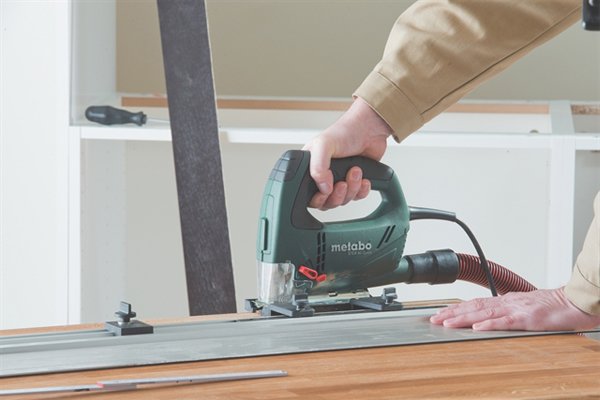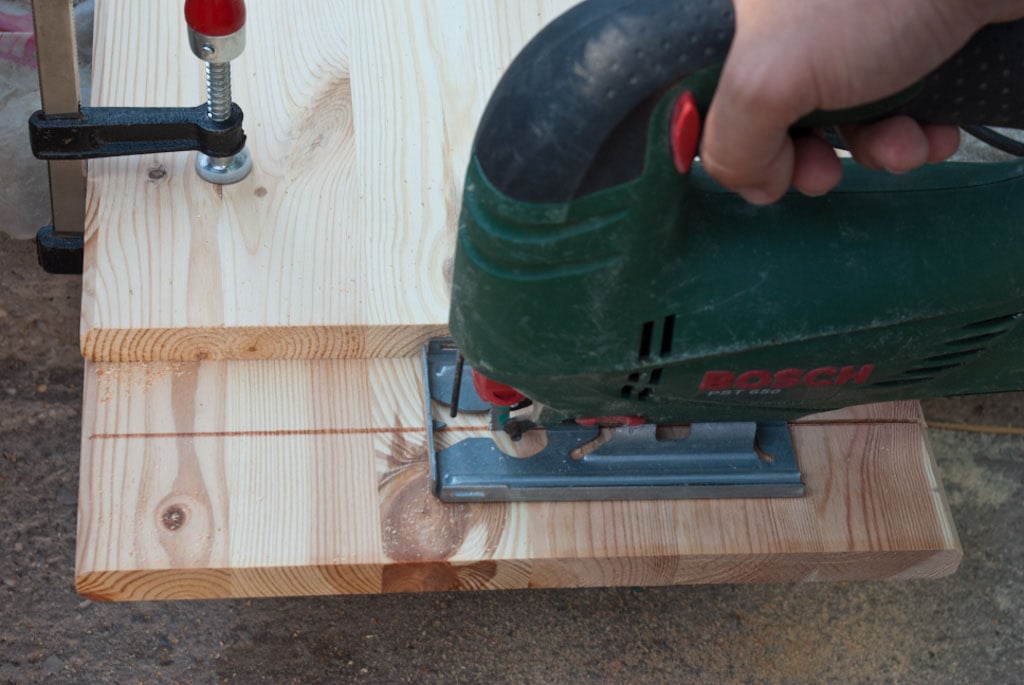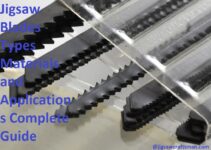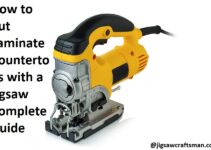Are you struggling to get straight cuts with your jigsaw? It can be challenging to make perfect cuts with a jigsaw, but the right technique and tools can help you get excellent results.
This article will provide you with the step-by-step guide to making perfect straight cuts with a jigsaw. You will learn how to use a jigsaw so that you can make effortless, precise cuts.
It is important to have precise and straight cuts when you’re working with wood. Working with a jigsaw can often lead to crooked and ragged edges, if you don’t do it properly. To get perfect cuts with a jigsaw, you will need to consider the blade size, the wood type and the specific instructions for proper set-up and use of the tool.
In this guide, we’ll take a look at all of these factors along with advice on how to achieve perfect straight cuts with a jigsaw.
Explanation of what a jigsaw is
A jigsaw is a power saw that uses a blade that moves up and down rapidly to cut through different materials. It can be used for straight and curved cuts, but for this guide, the focus will be on making perfect straight cuts.
A jigsaw is particularly useful when you need to cut large materials such as plywood, which can be thick and difficult to work with. The jigsaw makes it much easier as the blade moves rapidly up and down and cutting is much faster than with any other type of saw.
In addition, it’s capable of cutting a variety of shapes so you can make precise cuts in almost any shape or form. You’ll also get smoother edges with the jigsaw than you would using another type of saw.

Importance of making straight cuts with a jigsaw
When using a jigsaw, it is essential that the cuts be straight. Straight cuts form a template for most shapes that you will want to create and also determine how well the edges fit or match up. An uneven cut can easily ruin an entire project, so it’s very important to make sure your cuts are as straight as possible. With a jigsaw, there are several things you can do to ensure your straight lines come out perfect every time.
Practice makes perfect when it comes to precision cutting with a jigsaw. It’s a good idea to practice on scrap material before attempting any complicated projects. This allows you to get familiar with the saw and ensure that all settings are correct for clean and efficient cuts.
Using clamps or fixtures is necessary for most projects, since they help hold the material in place while being cut and make it simpler to stay on course during each pass of the blade. Take note of your push stroke when doing these clamp or fixed-angle cuts, so that the blade only moves one way through any given cut.
Watch out for curves or arcs in parts of your pattern — in these cases it’s essential that you keep both hands firmly placed on the saw handle throughout each pass of the blade so you don’t lose control over its direction mid-way through rather than starting and finishing with a full (forward) motion at all times throughout each cut stroke. Lastly, choose blades specifically designed for smooth cutting patterns — some blades can be gentle enough even not leave marks on wood fibers – and set your saw speed accordingly (usually around 2/3 depending on thickness).
Choosing the Right Blade
Choosing the right blade for your jigsaw is essential for getting perfect straight cuts. Blades come in a variety of materials and styles, so it’s important to know what you require for your job. While the best type of blade for straight cuts can vary depending on the type of material you’re cutting, aluminum oxide blades are often recommended as a good overall choice.
When selecting a blade, consider its width and tooth configuration—blades with fewer teeth cut faster, but create rougher edges. In general, blades with 2-3 teeth per inch (TPI) are used to rough cut harder materials like metal or plastics while blades with 12-14 TPI are used to finish cut softer materials like wood or some composites. It’s important to consider both the speed and quality of a cut when selecting the right jigsaw blade.
In addition to these general categories of blades, there are also specialty saw blades designed for different tasks such as making curves in wood or metal cutting discs specific to masonry work.
A Factors to consider when choosing a blade
Making perfect straight cuts with a jigsaw requires the proper blade for your project. Factors to consider when selecting blades include shape, size, tooth design and set, and materials. Knowing the material you’re cutting or the type of cut you are making will help you choose the right blade for your needs.
Shape: Blade shape is important when making straight cuts with a jigsaw. A blade with an offset point gives better control than one that is pointed at an angle. The offset helps draw holes against walls and body panels while still giving straight cuts on both sides of your material while the angled points make it hard to keep your line from wobbling during a cut.
Size: Jigsaw blades vary in size from 3/8” to 2 7/8” in length (4” for metal) so be sure to select a blade that is suitable for your project’s material thickness or tightness of bends in curves or angles. Longer blades offer better stability when making straight cuts but shorter blades can turn tighter curves or make more intricate cuts into confined spaces; like those found near windows and doorjambs, etc.
Tooth Design & Set: Tooth design and set refer to the size, spacing and design of teeth on the blade used when cutting different types of materials; wood vs metal vs other materials. Most wood jigsaw blades have points that slope backward along each side to provide smooth, clean edges as well as faster feed rates in many instances whereas metal saw blades feature sharp teeth designed to cut through tougher alloys such as steel or titanium alloys which require more power than wood saws do but may still act more like wood saws when dealing with softer metals like aluminum or magnesium alloys. Other special-use jigsaw blades have specific designs such as reverse-angled teeth which grab onto materials better and reduce splintering during use or diamond-grit coated blades for making fine slicing cuts into harder surfaces like ceramic tile or granite countertops where precision is required as well as extra strength due to their coating reducing friction caused by hot chips being formed by abrasive contact between the two surfaces being cut.
Materials: What kind of material will you be cutting? Wood, metal soft plastics etc., require different types of blades so once you know what type of material your jigsaw will be dealing with, you can narrow down your choices regarding suitable saws for making perfect straight cuts. Referring back to tooth design & set earlier, this may suggest certain types of blades better suited for a specific task than others but ultimately it comes down mainly to trial & error when it comes time to decide what works best under different circumstances so don’t hesitate being open up experimenting if needed!

How to install the blade
There are a few different types of blades available for a jigsaw. It’s important to choose the right blade for the job and to make sure it is securely attached to the saw. The common Type U blades feature a plain-end shank that fits most jigsaws. When installing these, make sure that the blade is facing the correct way. This can be found by looking at the direction of cut shown on the blade itself. With other blades, such as type T and type T/TT, there are two secure clamp screws which should be tightened down firmly before use.
When attaching a Type U blade, you will need to open up the saw’s jaws until they fit either side of the shank snugly. After this, press down on both sides of the saw’s release button and attach the blade ensuring it is precisely aligned between both hinges on each side. Then all that is left is to close over both jaws tightly before use – this will ensure your jigsaw can make straight cuts every time!
Setting Up the Jigsaw
Properly setting up the jigsaw is essential to a safe and successful operation. Begin by ensuring that the power connector is properly in place, then flip the switch to ensure it turns on. The blade should be attached firmly to the machine’s shank – consult your user’s guide for instructions on how to do this properly. Be sure that all safety guards are attached securely and that all nuts and bolts are tightened properly. Make sure you wear safety gear such as goggles or a face mask.
Next, choose an appropriate blade for your material – saw blades are designed for cutting different materials, so it is important to select one with the correct tooth type and configuration for your job. Finally, adjust any bevel settings as needed before powering your tool up.
Adjusting the shoe
- Adjusting the shoe – The best way to get precise cuts with a jigsaw is to adjust the shoe, or foot plate. This can easily be done by loosening the two clips on either side of the foot plate and moving it to where it’s parallel with the edge of your work piece. Tighten the clips firmly after you’ve adjusted it which will ensure that the shoe stays in place while cutting.
- Lining up your cut- After you have adjusted your foot plate, it’s important to have a complete and precise understanding of where your cut should lay on your project piece for perfect results. To line up straight cuts, you need to use a square to align with both edges as well as measure from each edge so that you’re aware of exactly how far away from each edge your cut should be. Place your cursor at this Measurement point and make sure that it lines up perfectly with one corner of The square before turning on the saw and making adjustments such as speed if needed before cutting into your piece.
Adjusting the speed
The speed of the jigsaw blade is another important factor in making perfect straight cuts. When cutting straight lines, it’s best to adjust the speed of the saw to a slower setting, as a slower pace helps maintain control and reduces the chances of a saw blade’s wandering, which can cause curved or crooked cuts.
The right saw speed also depends on the material being cut. For instance, softer materials such as aluminum require slower speeds — 1,500-2,000 strokes per minute (spm) — while harder materials such as steel need faster speeds — 2,500-3,000 spm. Refer to your saw’s instructions for guidance on adjusting speed settings based on material type.
Ensuring the blade is perpendicular to the material
The angle of the blade should be kept as close to perpendicular as possible in order to ensure accurate, clean cuts. This is especially important when cutting curves or intricate shapes where a slight change in the angle of the blade can affect the outcome significantly.
To begin, secure your material on a flat surface, ensuring that it is supported firmly and does not move. Adjust your jigsaw accordingly so that the blade is parallel to your cutting line and then tighten the screws on either side to keep it secure. Before operating your jigsaw, check that the baseplate of the tool is flush against the material you are cutting, with no gaps.
Once everything is in place and you’re ready to start, you may need to make small adjustments for perfect accuracy. Slowly guide your jigsaw along the cutting line while paying close attention to how far out or in the blade comes out of it. If it moves too far out or in, simply adjust your grip and positioning slightly until you get a consistent 90-degree cut – that is, when both sides of your cut are perfectly perpendicular lines with no curvature or imperfections. Ensure that you move at a consistent speed as well so that each cut looks neat and even throughout its length. When satisfied with your results, carefully release pressure from the saw before lifting away from your material for safety purposes.

Conclusion
At the end of it all, it is highly recommended to use a jigsaw with a great blade and an appropriate speed setting to make perfect straight cuts on your workpiece. Patience, skill and practice come in handy when perfecting these techniques so as to make perfect and accurate straight cuts every single time.
To ensure that you get the best results, make sure you buy the right saw for your needs as well as picking the right blades for each job. When using jigsaws to cut through hardwoods, take extra precaution by using clamps firmly attach thewood to a stable surface and making sure that you lowerthe blade gently onto the wood being cut.
Be safe by wearing protective equipment like goggles and dust masks while operating jig saws.
FAQS
How do I get my jigsaw to cut straight?
To get a jigsaw to cut straight, you can use a guide, clamp the material down, use a sharp blade, and cut at a slow and steady pace.
Can I use jigsaw for straight cuts?
Yes, a jigsaw can be used for straight cuts with the use of a guide or by following a straight line.
Why can’t I cut a straight line with my jigsaw?
You may not be able to cut a straight line with a jigsaw if the blade is dull or damaged, the material is not secured properly, or if you are using the wrong blade for the material being cut.
How do you cut a perfect square with a jigsaw?
To cut a perfect square with a jigsaw, you should first mark the cutting line, clamp the material down, and use a square as a guide to make the cuts.
How do you saw perfectly straight?
To saw perfectly straight, you can use a guide or a straight edge, make sure the material is secured properly, and cut at a slow and steady pace.
Why isn’t my saw cutting straight?
A saw may not be cutting straight if the blade is dull or damaged, the material is not secured properly, or if the saw is not being held or guided properly.
Do you cut up or down with jigsaw?
When using a jigsaw, it is generally recommended to cut on the upstroke to reduce chipping and ensure a cleaner cut.
How do I stop my jigsaw blade from wandering?
To stop a jigsaw blade from wandering, you can use a guide, clamp the material down, and cut at a slower speed. Using a sharp blade and maintaining control of the tool can also help prevent wandering.
What saw is best for straight cuts?
A table saw or circular saw is generally considered the best saw for making straight cuts.
Is circular or jigsaw better for straight cuts?
A circular saw is generally better for making long, straight cuts, while a jigsaw is better suited for making curved or intricate cuts.
See Also:
- Best jigsaw blades
- Best jigsaw for cutting curves
- Best jigsaw for woodworking
- Best jigsaw under 100
- Best jigsaw


